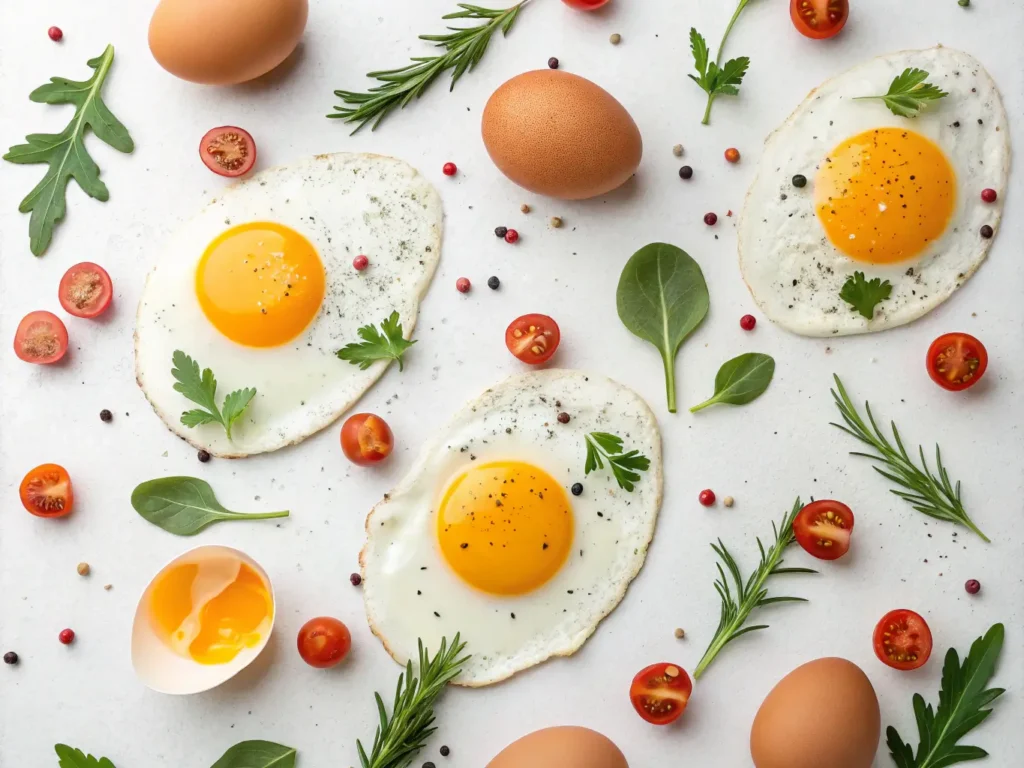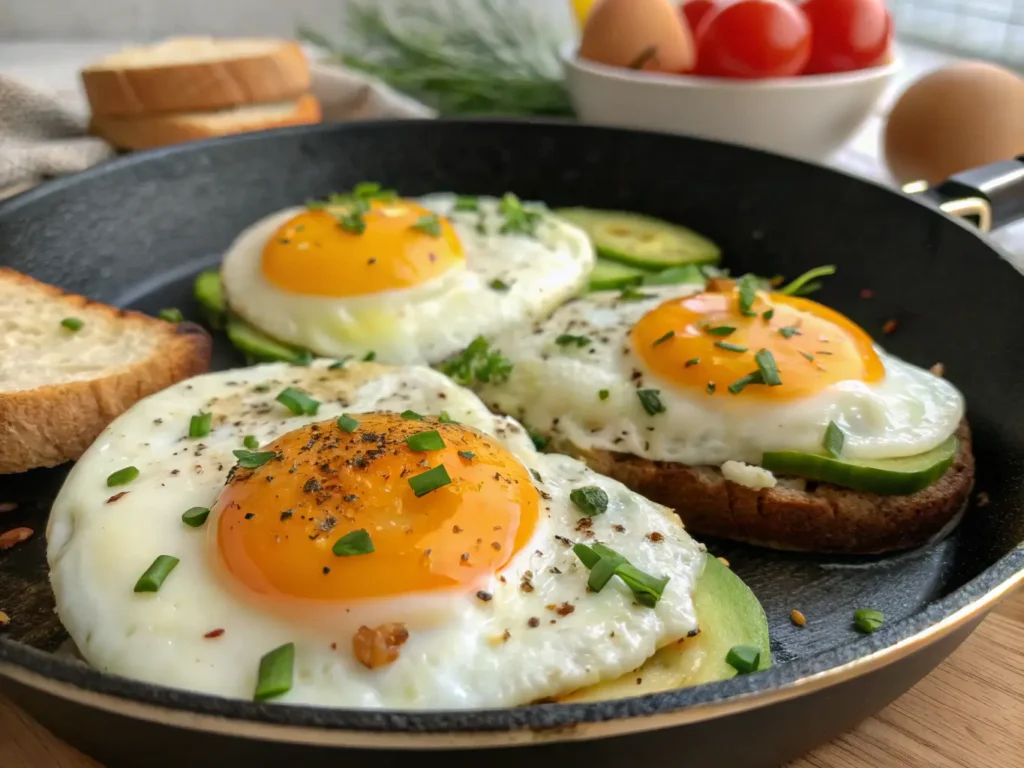Table of Contents
There’s something undeniably satisfying about a perfectly cooked over easy egg. Crisp edges, a delicate white, and a runny yolk—it’s no wonder this style of egg is a breakfast favorite. Learning how to make over easy eggs is a must for anyone who enjoys cooking simple, delicious meals with minimal effort. Not only are they a great addition to a breakfast plate, but they also serve as an excellent topping for burgers, rice bowls, and salads. Mastering this technique will elevate your cooking skills, allowing you to create perfect eggs every time. In this guide, we will walk you through everything you need to know, from the basics to expert tips for achieving flawless results.
What Are Over Easy Eggs?
Definition and Characteristics
Over easy eggs are fried on both sides. The white cooks completely while the yolk stays runny, offering the perfect balance of textures. The egg whites set without becoming crispy, and the yolk remains intact until you break it open. This style of egg is called “over easy” because you flip the egg during cooking, allowing it to cook through without overcooking the yolk.
Over Easy vs. Other Egg Styles
While over easy eggs are a classic choice, you will encounter several other egg styles in the kitchen. Here’s a quick comparison:
- Sunny side up: You fry the egg on one side only, leaving the yolk exposed and runny. The white sets but doesn’t fully cook on top.
- Over medium: This style is similar to over easy, but you cook the egg a little longer, resulting in a slightly firmer yolk.
- Over hard: You cook the egg until the yolk sets fully and becomes firm, leaving no runniness.
- Poached eggs: You cook eggs in water without the shell, creating a delicate, soft white and a runny yolk.
Over easy eggs are perfect for those who love a soft yolk but still want to cook the whites thoroughly.
Why Learn to Make Over Easy Eggs?
Learning how to make over easy eggs is important for a few reasons:
- Versatility: Over easy eggs are great for breakfast, but they also make a fantastic topping for dishes like rice bowls, avocado toast, or salads.
- Quick and easy: They require just a few ingredients and minimal time to prepare, making them a fast and satisfying option.
- Customizable: You can adjust the firmness of the yolk to suit your taste, making them a flexible addition to any meal.
Health Benefits of Over Easy Eggs
Rich in Nutrients
Eggs are packed with essential nutrients that contribute to a balanced diet. Over easy eggs provide a great source of protein, which is crucial for muscle repair and growth. Egg yolks are also rich in vitamins like vitamin A, D, and E, as well as omega-3 fatty acids—all of which support immune function and overall health. Egg whites are high in protein but low in fat, making them a great option for those looking to maintain a healthy diet.
Low-Calorie Breakfast Option
Over easy eggs are a low-calorie option, especially when compared to other breakfast foods. One large egg contains around 70 calories. By pairing your eggs with healthy sides like avocado, whole grain toast, or a side of veggies, you can enjoy a nutritious meal without consuming too many calories.

Minimal Ingredients, Maximum Nutrition
One of the best things about over easy eggs is how simple they are to make with minimal ingredients. In fact, you can create a flavorful meal using just eggs, butter or oil, and a pinch of salt and pepper. Moreover, this simplicity makes over easy eggs an excellent choice for those looking for a nutritious yet uncomplicated meal. Additionally, the ease of preparation ensures you can enjoy a satisfying dish without spending much time in the kitchen.
Ingredients Needed for Over Easy Eggs
Core Ingredients
- Fresh Eggs: Choose the best eggs you can find—free-range, organic, or pasture-raised eggs will yield the best results in terms of flavor and nutrition.
- Butter or Oil: You can use either butter or vegetable oil, depending on your preference. Butter adds a rich flavor, while oil provides a neutral base. Olive oil is a great healthier option if you want to add a light, fruity flavor.
- Salt and Pepper: Season the eggs lightly with salt and pepper to enhance their natural flavor.
Choosing the Best Eggs
When it comes to selecting eggs for over easy eggs, freshness is key. Always check the expiration date on the carton and look for eggs with the best before date as far in the future as possible. Free-range eggs typically have richer yolks, which result in better flavor and color. Additionally, if you’re looking for an environmentally friendly option, you should choose organic or pasture-raised eggs. These options are not only more ethical but also provide a more nutritious choice.
Butter vs. Oil
While butter adds a rich flavor to the egg, oil can provide a higher smoking point for cooking at higher temperatures without burning. If you’re cooking at medium-high heat and don’t want the butter to burn, vegetable oil or olive oil are better choices. For flavor, however, butter is often preferred as it gives the egg a creamy texture.
Equipment Needed to Make Over Easy Eggs
Cooking Tools
- Nonstick Skillet: A nonstick skillet is essential for cooking over easy egg. It prevents the egg from sticking to the pan and makes flipping the egg easier.
- Spatula: A spatula is necessary to gently lift and flip the egg. A wide spatula works best for larger egg.
- Small Bowl: It’s helpful to crack the egg into a small bowl before adding them to the skillet. This allows for easy inspection of the yolk and reduces the chance of breaking it.
Optional Accessories
- Ring Molds: If you want perfectly round egg, egg ring molds are an excellent option. Simply place the ring in the skillet and crack the egg inside.
- Lid: A lid can help cook the egg evenly, especially if you want to set the whites more quickly while keeping the yolk runny.
Step-by-Step Instructions for Making Over Easy Eggs
Preparing the Pan
- Heat the Skillet: Place a nonstick skillet on the stove and set it to medium-low heat. Add butter or oil, and allow it to melt evenly over the surface of the pan. Ensure the pan is well-coated but not swimming in oil.
Cracking the Eggs
- Crack the Eggs: Crack each egg carefully into a small bowl to ensure the yolk stays intact. Gently slide the egg from the bowl into the skillet, avoiding direct contact with the hot surface to prevent the yolk from breaking.
Cooking the Eggs
- Cook the Eggs: Allow the egg to cook for about 2-3 minutes without disturbing it. The egg whites should begin to set around the edges, and the yolk will remain runny. Do not move the eggs around, as you want the white to cook evenly while the yolk remains intact.
Flipping the Eggs
- Flip the Eggs: Using a spatula, gently lift the egg from the skillet. Quickly flip the egg over, being careful not to break the yolk. If you’re unsure, you can use a lid to cover the eggs while flipping to help them cook more evenly.
- Cook the Second Side: Allow the egg to cook for an additional 30 seconds to 1 minute, depending on how runny you want your yolk. For over easy eggs, the yolk should remain runny, but the white should be completely set.
Serving the Eggs
- Remove from the Pan: Once the egg are cooked to your liking, carefully remove them from the skillet using your spatula. Plate the egg immediately for the best texture and presentation.
Tips for Perfect Over Easy Eggs
Using the Right Heat
It’s crucial to use medium-low heat when cooking over easy egg. High heat can cause the white to become too crispy, while low heat ensures the egg cooks evenly without overcooking the yolk.
Preventing Sticking
To avoid sticking, always use a nonstick skillet and be sure to coat it well with butter or oil. If using a cast-iron skillet, make sure it’s well-seasoned.

Mastering the Flip
Flipping an over easy egg can be tricky, but it’s all about being gentle. Use a wide spatula to carefully lift the egg and flip it with a quick, confident motion. If you’re new to flipping, consider practicing with a less important egg first.
Variations of Over Easy Eggs
Spicy Over Easy Eggs
For a bit of heat, try adding a pinch of chili flakes, a dash of hot sauce, or cayenne pepper while cooking the egg. This adds a flavorful kick without overpowering the dish.
Herbed Over Easy Eggs
Enhance the flavor by sprinkling fresh herbs like parsley, chives, or dill over the egg just before serving.
Cheesy Over Easy Eggs
Top your egg with melted cheese for a decadent twist. Cheddar, Swiss, or even a tangy goat cheese work well.
Serving Suggestions for Over Easy Eggs
Breakfast Combinations
Pair your over easy egg with toast, avocado, crispy bacon, or pancakes for a complete breakfast meal.
As a Topping
Use over easy egg as a delicious topping for burgers, rice bowls, or even salads. The runny yolk adds richness and flavor to any dish.
Creative Presentations
Plate the egg with a garnish of fresh herbs, avocado slices, or a drizzle of sriracha to make your dish look as good as it tastes.
Common Mistakes to Avoid
Using Too Much Heat
Too much heat can overcook the egg white or cause the yolk to break. Always cook on medium-low heat.
Flipping Too Early
Wait until the whites are fully set before attempting to flip. Flipping too early can cause the yolk to break.
Breaking the Yolk
Handle egg gently to prevent breaking the yolk. A firm but gentle flip will help preserve the integrity of the yolk.
FAQs
Can I make over easy eggs without flipping?
To achieve the traditional over easy egg, flipping is necessary. However, you can cook egg sunny side up if you prefer not to flip.
What’s the best oil to use for cooking eggs?
Butter adds the best flavor, but olive oil and vegetable oil are also good choices depending on your preference.
How do I store leftover cooked eggs?
Store leftovers in an airtight container in the fridge and consume within 24 hours for the best texture.
Are over easy eggs safe to eat?
Yes, over easy egg are safe to eat as long as the white is fully set. Always use fresh egg from a reliable source.
How can I make this recipe dairy-free?
You can substitute vegan butter or olive oil for dairy in the recipe.
Can I use a cast-iron skillet instead of nonstick?
Yes, just make sure the cast-iron skillet is well-seasoned to prevent sticking.
Conclusion
Learning to cook the perfect over easy egg is an essential skill for any home cook. With practice, you’ll be able to make egg that are perfectly cooked with a runny yolk and crisp edges. By experimenting with flavors, you can make this dish even more exciting. So, gather your ingredients, get your skillet ready, and start mastering over easy egg today!

